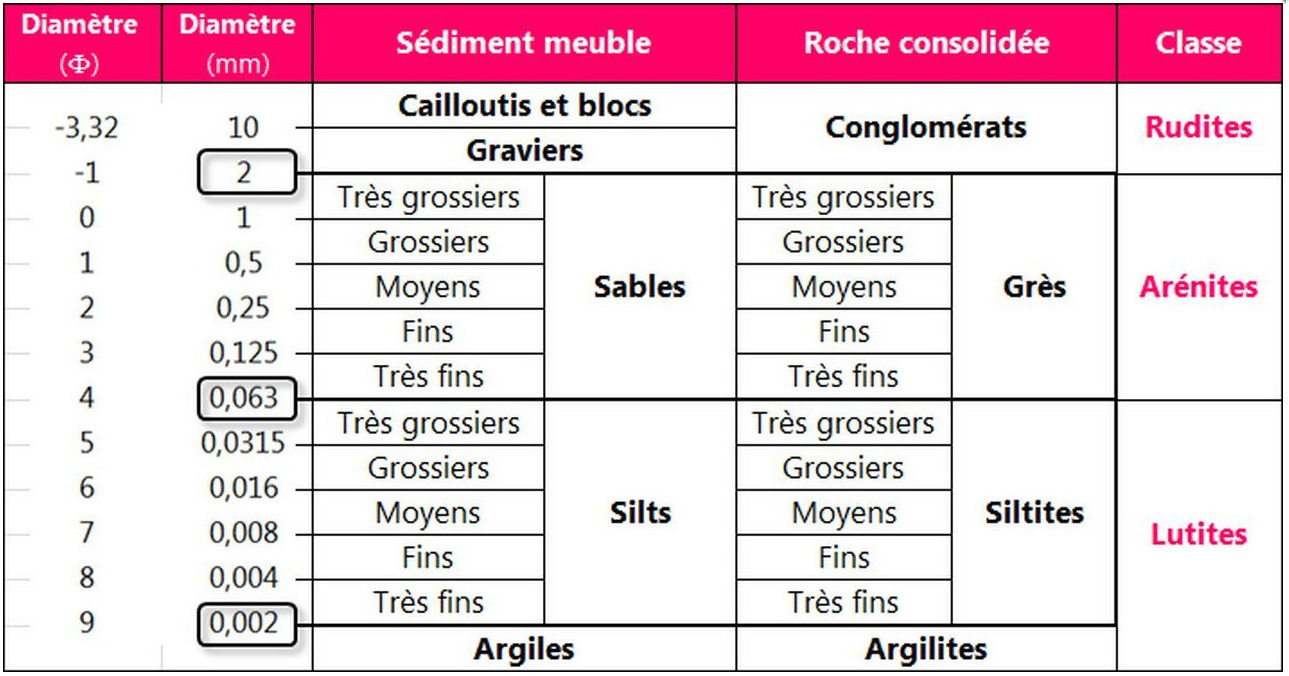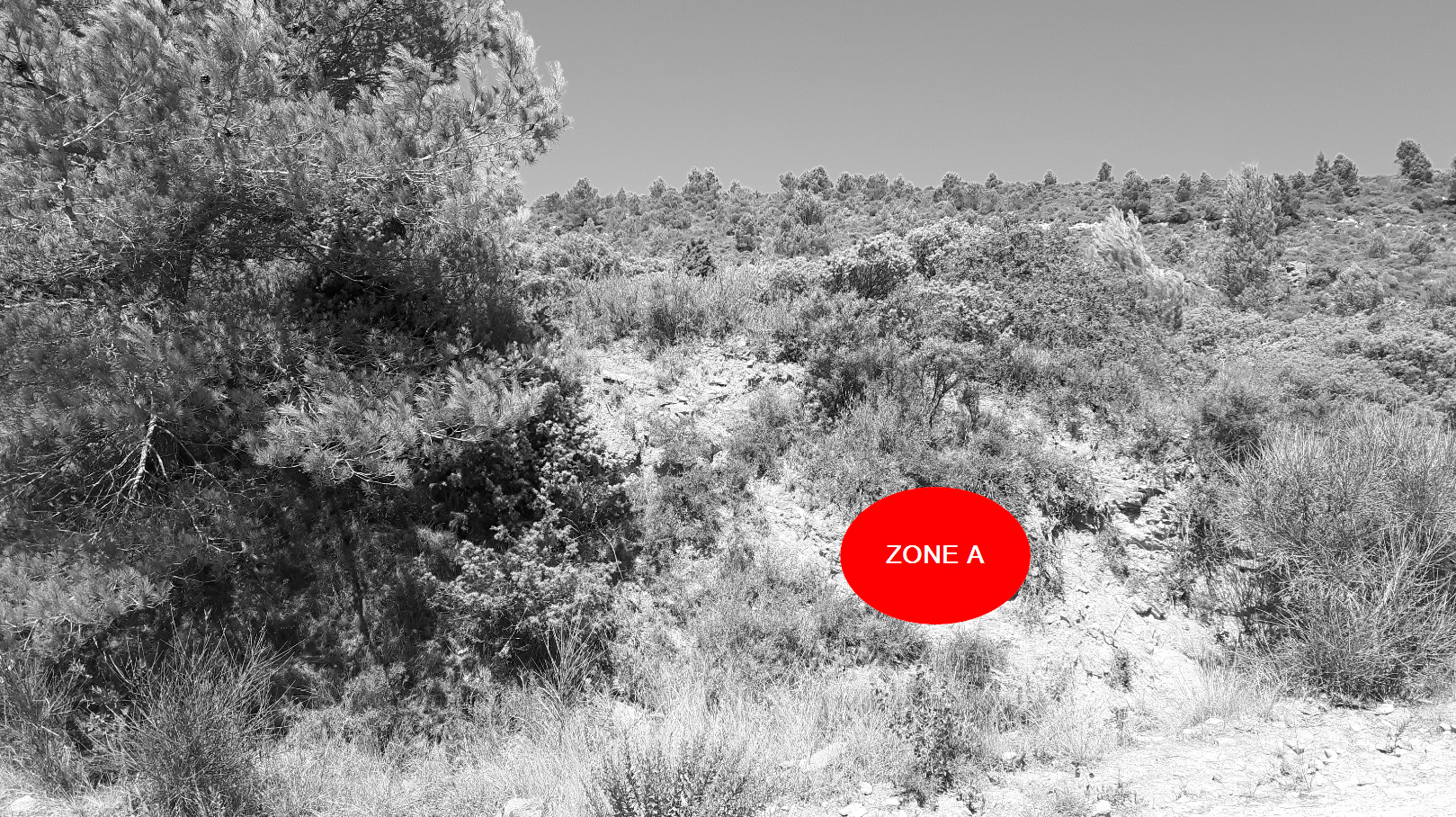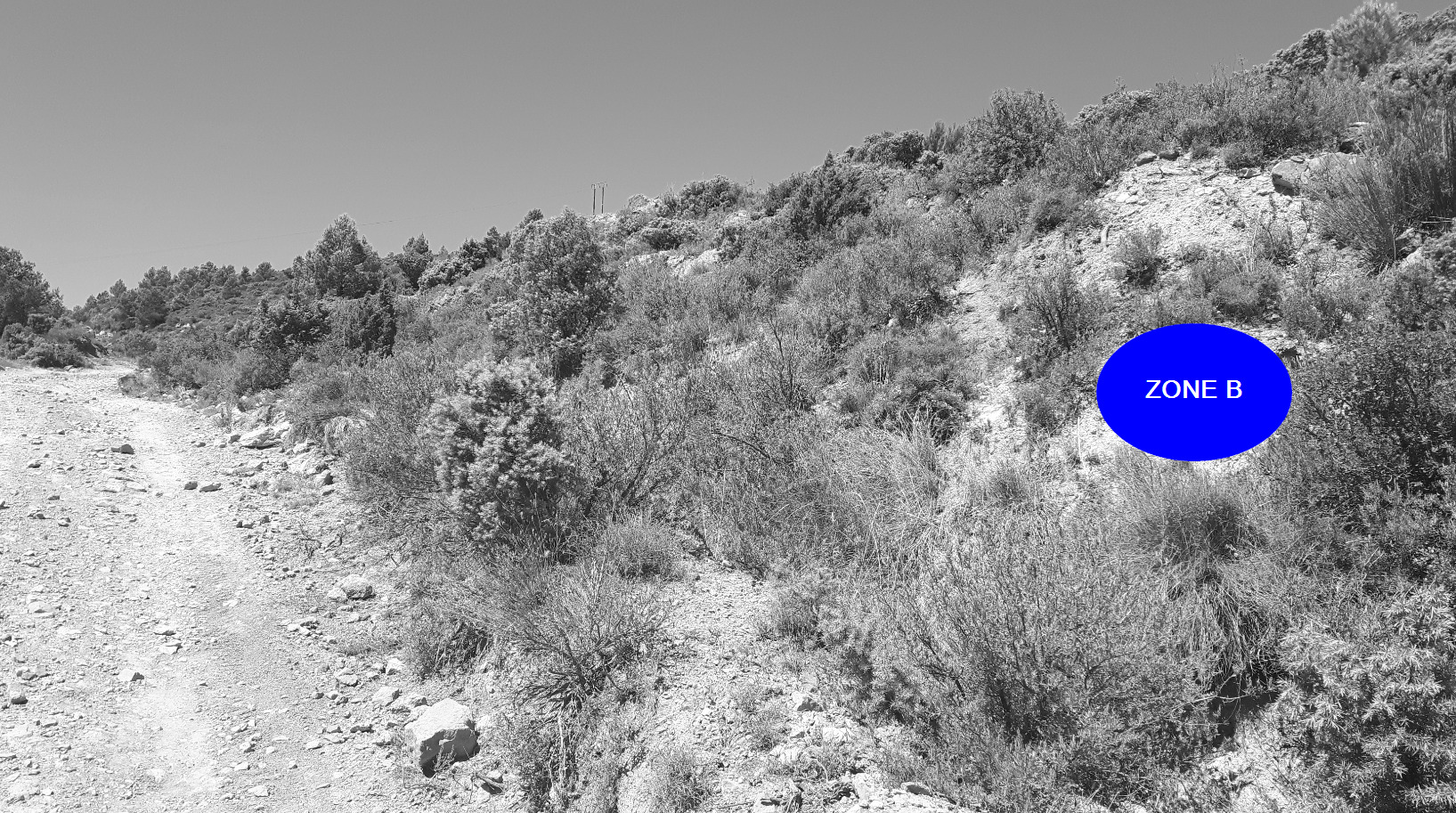
La Earthcache / The Earthcache
► Contexte géologique local
Sur les Hauteurs Nord d'Albas, on progresse dans les formations géologiques du Cénozoïque, et notamment l'ensemble "e2b - Thanétien supérieur - Marnes jaunes et calcaires lacustres".

Cette formation est l'occasion de découvrir quelques particularités géologiques.
► Les Marnes et Calcaires du Thanétien supérieur
La formation du Thanétien supérieur est assez hétérogène, avec des dépôts sédimentaires divers :
- Marnes jaunes à rouges
- Grès fins marneux à galets mous et terriers
- Un banc de calcaire lacustre gris sombre
Mais il présente surtout des petits bancs caractéristiques de deux faciès calcaires.
~ Faciès des calcaires gréseux cargneulisés
Les calcaires sont des formations sédimentaires issues de dépôts carbonatés dont la nature et les formes peuvent être très variables.
Dans le cadre d'un calcaire gréseux, il s'agit de fragments et de débris de coquilles calcaires qui sont de l'ordre du millimètre, donnant une texture grossière à la roche.
Par ailleurs, ce faciès présente un calcaire qui a subit le processus de cargneulisation.
Les roches cargneulisés sont des roches sédimentaires carbonatées, à l'aspect carié, vacuolaire, fréquemment bréchique.
De couleur jaune, les cargneules forment des masses peu ou non stratifiées et donnent des reliefs ruiniformes.
A l'origine il s'agit d'un calcaire riche en dolomite.
Au cours de la cargneulisation, il y a dissolution préférentielle de la dolomite par des eaux chargées en sulfates (principalement gypse). Ces mêmes eaux permettent la dédolimitisation (transformation de la dolomite en calcite).
Seul le calcaire a persisté, laissant cet aspect carié, vacuolaire.

~ Faciès des calcaires argileux
Nous sommes ici dans un faciès à la texture très fine, aux grains invisibles à l'oeil nu (texture argileuse).
Sa caractérisation se fait donc sur la classification granulométrique des sédiments, qu'il est aussi possible de caractériser par la texture de la roche au toucher.

Ce calcaire est très fin, de couleur gris-blanchâtre. Il est beaucoup plus tendre que le faciès gréseux cargneulisé et le fait de frotter la roche donne un résidu fin et collant sur les doigts.

► Local geological context
On the Heights North of Albas, we progress in the geological formations of the Cenozoic, and in particular the group "e2b - Upper Thanetian - yellow marls and lacustrine limestones".
This formation is the opportunity to discover some geological peculiarities.
The Upper Thanetian marls and limestones
The formation of the Upper Thanetian is quite heterogeneous, with various sedimentary deposits:
- Yellow to red marls
- Fine marly sandstone with soft pebbles and burrows
- A bench of dark gray lacustrine limestone
But above all, it presents small beds characteristic of two limestone facies.
~ Facies of cargneulised sandstone limestones
Limestones are sedimentary formations resulting from carbonate deposits, the nature and shapes of which can be very variable.
In the context of a sandstone limestone, these are fragments and debris of limestone shells that are on the order of a millimeter, giving a coarse texture to the rock.
In addition, this facies presents a limestone which has undergone the process of cargneulisation.
Cargneulized rocks are carbonate sedimentary rocks, with a decayed, vacuolar, frequently brecciated appearance.
Yellow in color, the cargneules form little or not stratified masses and give ruiniform reliefs.
Originally it is a limestone rich in dolomite.
During the cargneulisation, there is preferential dissolution of the dolomite by waters loaded with sulphates (mainly gypsum). These same waters allow dedolimitization (transformation of dolomite into calcite).
Only the limestone persisted, leaving this decayed, vacuolar aspect.
~ Facies of clayey limestones
We are here in a facies with a very fine texture, with grains invisible to the naked eye (clay texture). Its characterization is therefore based on the granulometric classification of the sediments, which it is also possible to characterize by the texture of the rock to the touch.
This limestone is very fine, gray-whitish in color. It is much softer than the cargneulised sandstone facies and rubbing the rock gives a fine, sticky residue on the fingers.
► Sources bibliographiques / Bibliographical sources
Les Questions / The Questions
Questions pour valider :"Les Cargneules d'Albas"
Questions to validate: "The Cargneules of Albas"
- Question 0 : Prenez une photo de vous ou d'un élément vous appartenant sur site, mais sans avoir les Waypoints de visible.
Cette photo devra au choix nous être transmise avec les réponses ou être ajoutée à votre log.
-Question 0 : Take a photo of yourself or an item you own on site, but without having the Waypoints visible.
This photo must either be sent to us with the answers or added to your log.
Point 1 : N 43° 00.541 E 002° 43.746
Sur la gauche du chemin depuis le bourg d'Albas, vous pouvez voir un affleurement (photo WP1).
On the left of the path from the village of Albas, you can see an outcrop (photo WP1).

- Question 1 : Décrivez la roche sous la zone rouge A (texture, forme de la roche, couleur). Déduisez-en le faciès de la formation du Thanétien supérieur.
- Question 1: Describe the rock under the red zone A (texture, rock shape, color). Deduce the facies of the formation of the Higher Thanetian.
- Question 2 : En fonction de l'aspect de cette roche, quelle qualificatif pouvait vous lui donner ? Comment est-on arrivé à cet aspect ?
- Question 2: Depending on the aspect of this rock, what qualifier could you give it? How did we arrive at this aspect?
Point 2 : N 43° 00.627 E 002° 43.867
Poursuivez jusqu'au WP2 et observez l'affleurement sur la droite du chemin (photo WP2).
Continue to WP2 and observe the outcrop on the right of the path (photo WP2).

- Question 3 : Décrivez la roche sous la zone rouge B (texture, forme de la roche, couleur). Frottez-là avec vos doigts qu'obtenez-vous ?
- Question 3: Describe the rock under the red zone B (texture, rock shape, color). Rub it with your fingers what do you get?
- Question 4 : Du point de vue de la classification granulométrique, de quel type de sédiments est fait cette zone ? Déduisez-en le faciès de la formation du Thanétien supérieur.
- Question 4: From a granulometric classification point of view, what type of sediment is this area made of? Deduce the facies of the formation of the Higher Thanetian.
Vous pouvez vous loguer sans attendre notre confirmation,
mais vous devez nous envoyer les réponses en même temps soit par mail via notre profil (
fafahakkai), soit via la messagerie geocaching.com (Message Center).
S'il y a des problèmes avec vos réponses nous vous en ferons part.
Les logs enregistrés sans réponse seront supprimés.
You can log this cache without waiting for our confirmation, but you must send us the answers at the same time, by e-mail via our profile (fafahakkai) or by the system of Message Center of geocaching.com.
If there is a problem with your answers we will notify you. The logs recorded without answers will be deleted.
Rappel concernant les « Earthcaches »: Il n'y a pas de conteneur à rechercher ni de logbook à renseigner. Il suffit de se rendre sur les lieux, de répondre aux questions ci-dessus et de nous renvoyer les réponses.
Reminder concerning "Earthcaches": there is neither a container to look for nor a logbook to sign. One need only go to the location, answer to the differents questions and send us the answers.